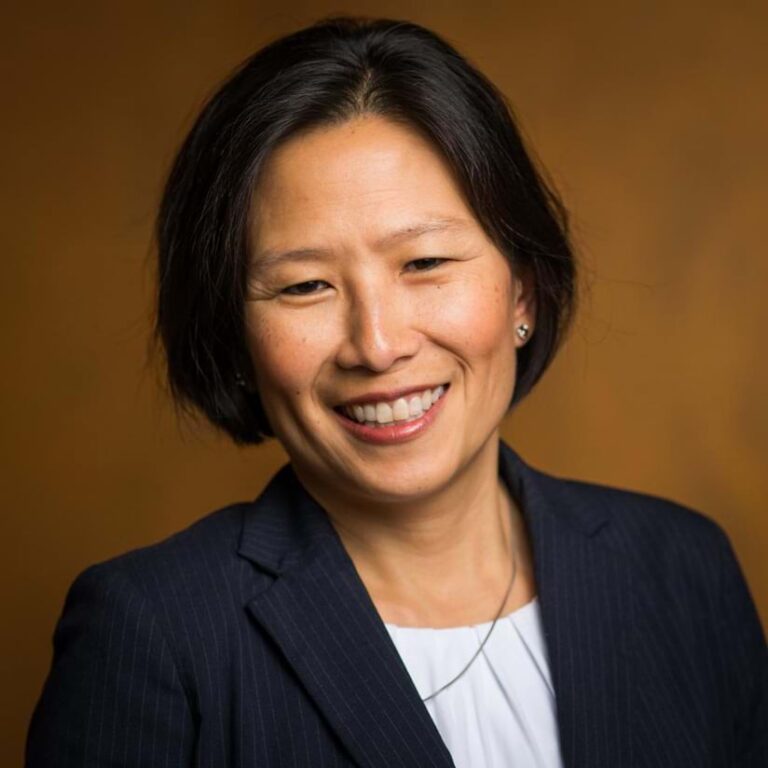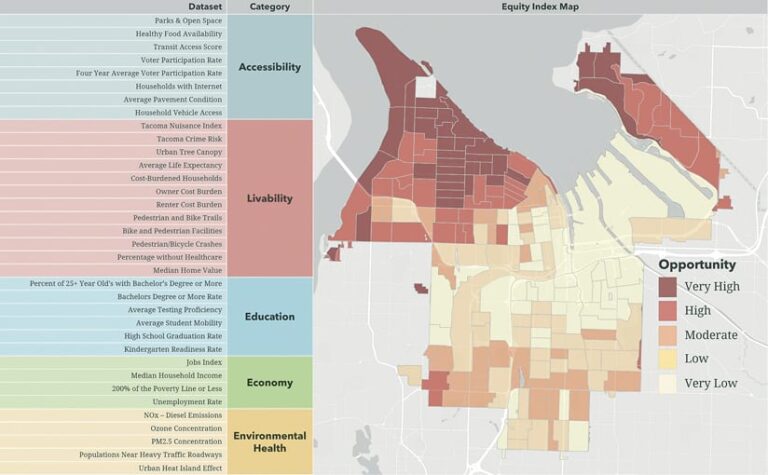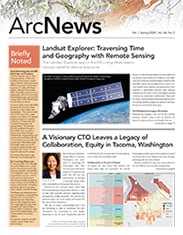Grace Brosnon, chief technology officer of Tacoma, Washington, isn’t interested in technology for technology’s sake. That was why, years after developing her IT expertise, she dived into GIS and was instrumental in growing a prototype equity index into a sustainable and integrated GIS product.

Powered by GIS, Tacoma’s Equity Index Map is used to help make equitable decisions regarding asset management, budget proposals, new policies, department goals, and racial equity action plans for the city’s 18 lines of business.
“For me, it’s about understanding how I can use technology to help do something,” she said. “Sometimes the technology is very simple. Sometimes it can be more complicated, like GIS or SAP. But it’s the outcomes that I’m interested in, more so than the technology itself.”
Collaboration in Pursuit of Equity
To support the city’s Vision 2025 initiative, the Equity Index Map was developed. The ArcGIS technology-enabled equity index started as a proof of concept and is now integral to the city’s strategic planning goals and data analysis.
Brosnon credited her team and several others for the city’s effective use of ArcGIS, noting that the knowledge and creativity of the city’s GIS analysts led to the platform that allowed her and others to expand and promote the equity index.
“It really takes a whole team and the business all around it to be able to do something like the equity index, and for us, that’s how we ended up having, in my mind, one of the greatest things that I’ve done in my career,” said Brosnon.
Integral to that team was Tacoma’s GIS division, led by James Osundwa. The timing was optimal, he said, noting that the years spent building the tool aligned with the city’s racial equality goals.
Brosnon agreed, adding, “Having that history with the tools and the capabilities is great, but what we did with the equity index really began by having clear business goals we wanted to achieve and assembling those with the passion to see it through.”
To build the original index as a one-off analysis, Tacoma’s Office of Equity and Human Rights partnered with the Kirwan Institute for a study on race and ethnicity at Ohio State University. City leadership and GIS analysts have kept the index going for the past five years, enhancing it with geographic representation, more equity measures, updated census data, and other data, for the benefit of community members, customers, and business owners.
The index was recognized at the 2023 Esri User Conference with a Special Achievement in GIS Award. Osundwa has since developed a strategic plan to enhance the city’s assets and view these investments through an equity lens. He also hopes to advance and expand the city’s GIS programs. He wants to implement self-service options that will allow for a greater number of GIS users in the city in the future.
How Tacoma’s Equity Index Works
The equity index scores 153 census block groups in Tacoma by 32 different indicators sorted into five categories—accessibility, livability, education, economy, and environmental health—to show the disparities in residents’ access to services and opportunities. It’s used for everything from equitably distributing small business loans to making utility upgrades to planning affordable housing.

“The index has definitely grown collaboration, not just within the city but with different municipalities in the region asking us for advice on how to do something similar,” Osundwa said.
A Career of Connection
Throughout her 25-year career, Brosnon has advocated using technology to connect business needs and people. Her interest in science, technology, engineering, and mathematics began during her time as an electrical engineering student at Harvey Mudd College in Claremont, California, and was further fueled by an internship that prompted her shift toward technology consulting.
Her early career was driven by her passions for travel, technology, and working with people. During this time, she held multiple positions where she implemented software systems internationally and eventually ran her own consulting company. “Seeing technology [as] having a specific purpose and goal, rather than just being a product, has always been a source of inspiration for me and why IT was a good fit for me as a career,” she said.
In 2000, Brosnon took a sabbatical to spend more time with her growing family. “I was lucky that I financially could take that time,” she said, “As long as you’re dedicated and passionate about your career, you can always find your way back to it.”
As her sabbatical drew to a close, Brosnon explored different career options that would allow her to balance having school-age children and work. This led her to a remote position, working in IT for a private technology company. However, Brosnon wanted a job where she could assist and engage with others in person and have more opportunities to serve the community. This led to her work for the City of Tacoma, where she has been employed for the last decade. She plans to retire in May.
Finding Strategic Opportunities to Help People
As the city’s CTO, Brosnon said, she takes on many roles depending on the city’s needs. “Sometimes I’m trying to negotiate big contracts and ensure fiscally and technically responsible road maps that align with business strategies like other CTOs do,” she said. “Other times, it’s that ‘other-duties-as-assigned’ bucket that gets quite large but is most rewarding, like sponsoring the Asian/Pacific Islander affinity group or helping college students with their résumés.”
According to Osundwa, “One of the things I think Grace does so well as a leader is focusing on people and engaging with them at a personal level, optimizing their strengths and motivations so we deliver excellence in our work for the city. Grace is passionate and tenacious about our work, particularly in finding strategic opportunities, like where we can integrate better or improve processes to outlive us when we’re gone and make an impact. It’s been a fun and intense journey to work with her on high-impact and high-value projects for the city.”
Whether helping a department set goals and enhance operations via technology, creating internal presentations, helping new executives get acclimated, or making budget requests, Brosnon prioritizes her work through the lens of doing “the right thing for the city and community,” she said. “If I can use technology to directly help people, like the equity index did, that’s even better.”

